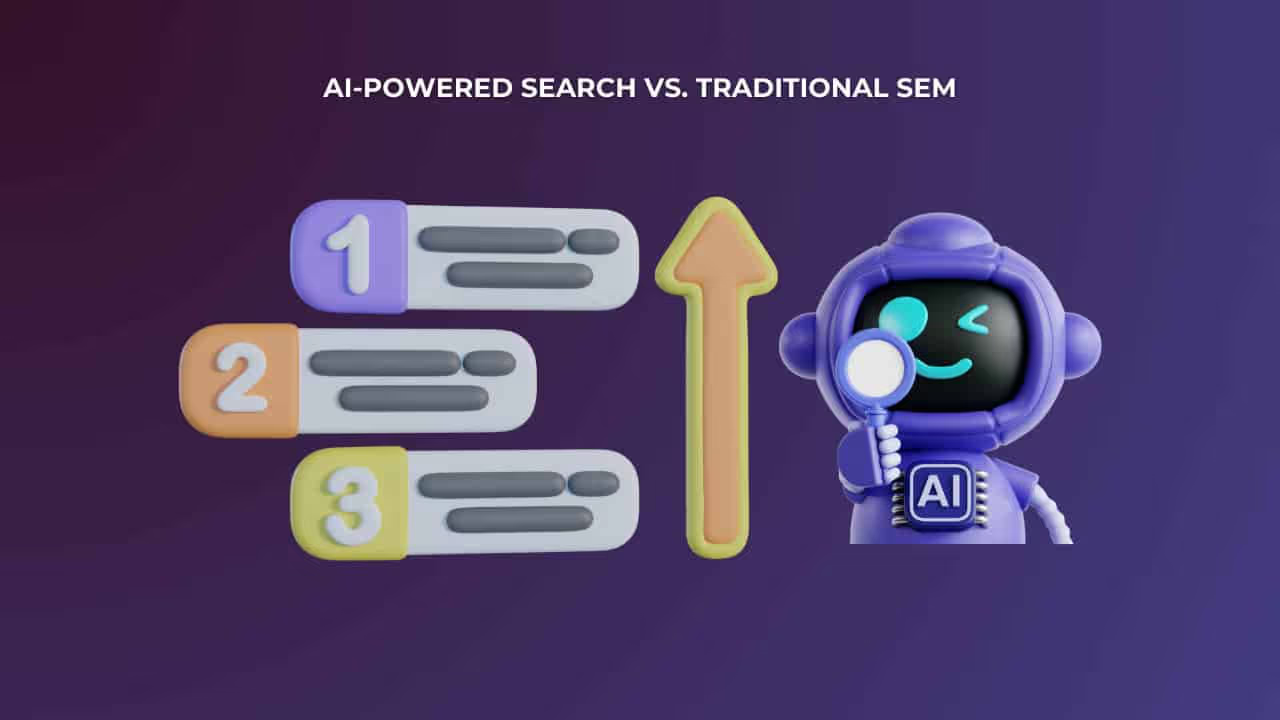Google’s search experience is evolving rapidly and the rise of AI-powered search is changing how users interact with content and how marketers drive visibility. If your paid ads or SEO strategy hasn't been adapted yet, you might already be falling behind.
In this post, we break down the facts, challenges, and opportunities marketers need to navigate the AI-powered search revolution.
The Shift: From SEM Dominance to AI-Powered Search Results
For years, Search Engine Marketing (SEM) dominated the top of Google’s search engine results pages (SERPs). Today, those spots are being overtaken by AI-powered search elements — particularly Google’s AI Overviews, formerly called Search Generative Experience (SGE). These summaries, powered by the Gemini model, deliver quick answers directly in the SERP.
This transition represents more than just a layout change, it's a fundamental evolution in the search experience, with massive implications for visibility, CTR, and brand discoverability.

SEM vs. AI Overviews: How They Work
Traditional SEM Ads
- Appear at the top or bottom of SERPs with a “Sponsored” label.
- Involve keyword bidding and pay-per-click (PPC) strategies.
- Designed to drive traffic to external sites or landing pages.
Google’s AI Overviews
- Generated by Google’s Gemini AI using multiple data sources.
- Appear at the very top of the SERP, often before both paid and organic results.
- Present in-SERP answers with citations, reducing the need to click.
This new AI-powered approach enables "zero-click searches" — users get answers without ever leaving Google — impacting both paid and organic strategies.
Early Impact on Paid Search Performance
The rise of AI Overviews is already affecting SEM campaigns in measurable ways:
- CTR drops over 25% when AI summaries are shown above ads (Accelerated Digital Media).
- Top 3 paid positions saw CTR fall from 1.7% to 1.5% on average (First Page Sage).
- When brands are featured in AI Overviews, organic CTR increases from 0.74% to 1.02% (Seer Interactive).
Clearly, AI-powered search not only alters visibility but also shifts where users click and how brands are discovered.
Layout Changes: AI-Powered Search Takes Prime Real Estate
With AI-powered search elements like AI Overviews taking up massive screen space:
- In 84% of tested queries, the AI section covered more than half the screen (DataFeedWatch).
- Shopping ads appear above AI summaries in 81% of cases, while standard paid ads vary in placement (Search Engine Land).
This reallocation of SERP real estate means marketers must re-strategize for a search landscape driven by AI.

How Marketers Can Adapt Now
1. Optimize for AI Visibility
To increase your chances of being cited:
- Use concise, structured content with clear answers.
- Optimize for long-tail, natural language queries.
- Leverage FAQ sections, schema markup, and structured data.
- Prioritize topical authority and E-E-A-T (Experience, Expertise, Authoritativeness, and Trustworthiness).
2. Adapt Paid Search Strategy
- Focus on bottom-of-funnel, high-intent keywords.
- Monitor which queries trigger AI summaries and where your ads appear.
- Consider alternative platforms (e.g., Bing) for better visibility.
- Track performance shifts and adjust bidding strategies accordingly.
3. Rethink Content Marketing for the AI Era
- Develop content that directly answers user questions.
- Incorporate multimedia (images, video, product visuals) to boost engagement and inclusion in AI Overviews.
- Update older content to align with AI-powered search formatting.
Why AI-Powered Search Is Also an Opportunity
Despite the challenges, AI-powered search opens new doors:
- Brand mentions in AI Overviews improve awareness and authority.
- Encourages creation of higher-quality, intent-aligned content.
- Delivers user behavior insights from AI-triggered queries.
- Fosters conversational search, where follow-up questions create new engagement paths.

Real Risks Marketers Must Address
Of course, it's not all upside:
- Lower CTRs for both paid and organic listings.
- Unpredictable ad placements and reduced visibility.
- AI inaccuracies or bias — summaries may misrepresent your brand (Odyssey New Media).
The Future of Search Is AI-Powered
We're not just adapting to a new feature — we're entering a new paradigm. Here’s what’s on the horizon:
- A shift from “search engines” to “answer engines” — a conversational, context-aware search experience.
- Understanding user intent and behavior is more important than keyword ranking alone.
- An increased focus on brand authority and direct customer relationships.
Final Takeaway: Embrace the AI-Powered Search Evolution
AI-powered search is no longer a beta test — it’s shaping how people search, how Google delivers content, and how brands are discovered.
Success in this environment means:
- Creating content that earns trust — and AI citations.
- Realigning SEM tactics to complement, not compete with, AI Overviews.
- Using Dataslayer tools to analyze and adapt — fast.
The bottom line? While AI Overviews may reduce some traditional metrics, they reward the brands that provide value, relevance, and trust. And that’s where the future of search — and your strategy — should be heading.







